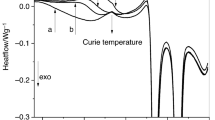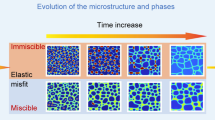The possibilities of application of known models of domain structure to multiphase alloys are analyzed with the aim to assess the anisotropy constants and to search for magnetically uniaxial highly anisotropic phases. It is shown in what cases and how the standard models of domain structure may be applied to such alloys. Recommendations on the necessary amendments of the model to be applied to multiphase materials are given.


Similar content being viewed by others
Notes
The authors are obliged to E. M. Semenova for the help with conduction of the experiments.
References
H. Koinuma, H. Aiyer, and Y. Matsumoto, “Combinatorial solid state materials science and technology,” Sci. Technol. Adv. Mater., 1, 1 – 10 (2000).
B. Fayyazi, K. P. Skokov, T. Faske, et al., “Bulk combinatorial analysis for searching new rare-earth free permanent magnets: Reactive crucible melting applied to the Fe – Sn binary system,” Acta Mater. (2017) (DOI: https://doi.org/10.1016/j.actamat.2017.09.036).
D. Goll, R. Loeffler, J. Herbst, et al., “High-throughput search for new permanent magnet materials,” J. Phys. Condens. Matter, 26, 064208 (2014).
J. Pastushenkov, A. Forkl, and H. Kronmüller, “Magnetic domain structure of sintered Fe – Nd – B type permanent magnets and magnetostatic grain interaction,” J. Magn. Magn. Mater., 101, 363 – 36 (1991).
Yu. G. Pastushenkov and K. P. Skokov, “Magnetic microstructures in rare earth intermetallics: quantitative analysis of micro-magnetic parameters and magnetic reversal,” in: Proc. Rare-Earth and Future Permanent Magnets and their Applications (REPM-2016) (2016), p. 713.
Yu. G. Pastushenkov, Magnetic Domain Structure. Quantitative Analysis of Micromagnetic Parameters [in Russian], TvGU, Tver (2007), 157 p.
A. Hubert, “Zur Theorie der Zweiphasigen Domänenstrukturen in Supraleitern und Ferromagneten,” Phys. Status Solidi, 24, 669 – 682 (1967).
Ch. Kittel, “Theory of structure of ferromagnetic domains in films and small particles,” Phys. Rev., 70(11), 965 – 971 (1946).
J. Kazer, “On the domain structure on uniaxial ferromagnets,” Sov. Phys. JETP, 19(5), 1204 – 1208 (1964).
R. Szymzak, “Observation of internal domain structure of barium ferrite in infrared?” Acta Phys. Polonica, A43(4), 571 – 578 (1973).
G. S. Kandaurova and V. N. Beketov, “A model of complex domain structure of magnetically uniaxial crystal,” Fiz. Tverd. Tela, 16, 1857 – 1862 (1974).
R. Bodenberger and A. Hubert, “Zur Bestimmung der Blochwandenergie von einachigen Ferromagneten,” Phys. Status Solidi A, 44, K7 – K11 (1977).
M. Sagawa, S. Fujimura, H. Yamamoto, et al., “Magnetic properties and microstructure of rare earth-iron-boron permanent magnet materials,” in: Proc. 4th Int. Symp. on Magn. Anisotropy and Coercivity in RE-TM alloys, Dayton (1985), pp. 587 – 609.
D. Plusa, J. J. Wyslocki, D. Wyslocki, and R. Pfranger, “Domain structure and domain-wall energy in polycrystalline R2Fe14B compounds,” J. Less-Common Met., 133, 231 – 243 (1987).
S. Tikadzumi, The Physics of Ferromagnetism. Magnetic Characteristics and Applications [Russian translation], Mir, Moscow (1987), 420 p.
The work has been supported by Grant No. 16-02-00472 of the Russian Foundation for Basic Research and Project No. 3.7849.2017/8.9 of the Ministry of Education and Science of the Russian Federation.
Author information
Authors and Affiliations
Corresponding author
Additional information
Translated from Metallovedenie i Termicheskaya Obrabotka Metallov, No. 8, pp. 57 – 59, August, 2018.
Rights and permissions
About this article
Cite this article
Pastushenkov, Y.G., Skokov, K.P. & Zhukov, A.I. Quantitative Analysis of Domain Structure and Rapid Search for New Materials for Permanent Magnets. Met Sci Heat Treat 60, 544–547 (2018). https://doi.org/10.1007/s11041-018-0316-0
Published:
Issue Date:
DOI: https://doi.org/10.1007/s11041-018-0316-0




